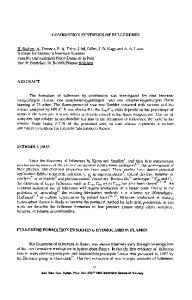Effect of iron and cobalt addition on TiC combustion synthesis
- PDF / 1,958,490 Bytes
- 8 Pages / 576 x 792 pts Page_size
- 93 Downloads / 332 Views
Fe and Co metals were incorporated into a Ti and C mixture with a molar ratio of 1.0 over the range of 0 to 40 wt. % to study their effect on TiC combustion synthesis. The addition brought about the grain size decrease, change of grain shape (angular to spherical), and different distribution (agglomerated to isolated) of TiC grains. Both Fe and Co additives were distributed around TiC grains and served as a binder. It was observed that reaction between Ti and C was kinetically more favorable than any other reactions in the T i - C - F e or T i - C - C o system. Based on the activation energy from an Arrhenius plot of ln[(l — w)mu/Tc] vs \/Tc, which was obtained by combustion temperature and wave velocity measurements, the reaction mechanism in combustion synthesis of TiC with the addition of 20 wt. % Fe and Co was suggested.
I. INTRODUCTION Among the composites of ceramics and metals, the titanium carbide-metal system has drawn much attention because of its extreme hardness and toughness. These composites have been produced by liquid-phase sintering between titanium carbide and metals. Nickel as a metal binder for liquid phase sintering has been conventionally used.1'2 If chemical reaction between elements is highly exothermic, the reaction can be self-sustained in the form of combustion-wave propagation by the heat liberated from the reaction. This reaction has been recently utilized for a variety' of materials including refractory3"6 and intermetallic7"9 compounds. This is called selfpropagating high-temperature synthesis (SHS) or combustion synthesis and it has been further developed by Merzhanov and co-workers since the 1960s.10 Recently, the formation of TiC-metal composites by the combustion reaction of Ti, C, and metals has been studied by several researchers.11"16 Dunmead et al. have studied the kinetics of combustion synthesis reaction in the T i - C and T i - C - N i systems.13 Dunmead et al. synthesized and densified TiC/Ni—Al composites simultaneously by initiating combustion reaction under high pressure.14 Gabriel et al. studied the characteristics of the nickel-doped and aluminum-doped titanium carbide synthesized by combustion reaction.16 In the present work, Fe and Co were incorporated into a reactant mixture of Ti and C with a molar ratio of 1.0 to study their effect on TiC combustion synthesis. Fe was selected as a metal additive because the TiC-Fe system had some unique characteristics that could be annealed and worked by normal machining techniques and then hardened by subsequent heat treatment.17 Co was selected because it had the ability of sufficiently 3202 http://journals.cambridge.org
J. Mater. Res., Vol. 8, No. 12, Dec 1993 Downloaded: 13 Mar 2015
wetting the surface of TiC particles to ensure good binding.18 On the other hand, their effects on the TiC combustion synthesis reaction have not been clearly identified. In this research, effects of Fe and Co on microstructure, composition, and component distribution in the reaction product were studied. Combustion temperature and wave veloci
Data Loading...











